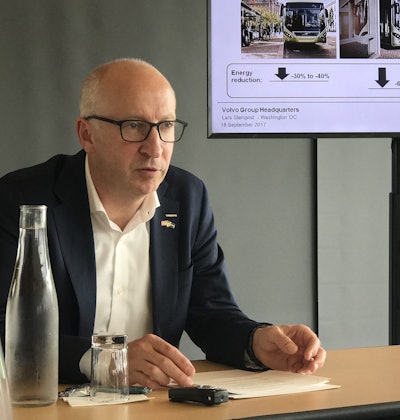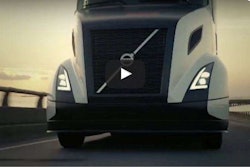 Lars Stenqvist, Volvo Group chief technology officer, says this is the most fascinating and challenging era ever for truck design and technology.
Lars Stenqvist, Volvo Group chief technology officer, says this is the most fascinating and challenging era ever for truck design and technology.While there have been great advancements in recent years in global truck technology, OEMs and industry suppliers must continue to rapidly develop new solutions, said Lars Stenqvist, chief technology officer, Volvo Group, and executive vice president, Volvo Groups Trucks Technology. “Our customers are waiting for it, legislators are waiting for it and I would say society is waiting for it.”
Stenqvist shared his thoughts with the North American trucking industry press during a media roundtable to discuss the future of transportation technology at the Swedish Embassy in Washington, D.C.
“The future is more uncertain than ever, and more changes will happen in [truck development] in years to come than has happened ever before,” he added. “This is the most fascinating and most challenging era ever.”
Unlike other technology-related industries, Stenqvist believes trucking’s reliance on well-known technologies hinders the development of new systems and approaches to truck designs and transportation systems.
He adds, however, there is still much to explore with existing technologies. With all the talk about electric-hybrid and all-electric powertrains, Stenqvist says talk of diesel’s death is premature and that the traditional combustion engine “will be the foundation of long-haul freight for many years to come. We are investing heavily in next-generation combustion engines, and it still has a lot of development potential.”
Stenqvist cited Volvo’s new wave piston – a design concept that arose from the SuperTruck program that adds “waves” to the piston crown – that yielded a 2 percent improvement in fuel efficiency and 90 percent reduction in soot. “As our engineers come up with designs that can improve fuel economy by even 0.1 or 0.2 percent, we will introduce that immediately.”
As for other existing systems, Stenqvist said the industry must invest in and continue developing transmissions, rolling resistance technology and aerodynamics.
Building upon these existing technologies, Stenqvist said Volvo Group also is investing in new technologies such as automation, electromobility and connectivity. “Each of those can impact transport,” he said. “When they converge, then we see radical shifts in transportation and to societies. It will start in city centers. That is where we will see the paradigm shift first.”
As more municipal governments across the globe set target dates for zero-emission zones in large cities, electromobility will play a more important role in freight transportation, especially for final mile. “It has already been a game-changer when it comes to buses,” said Stenqvist.
Stenqvist believes refuse collection is a natural application for electromobility in medium-duty trucks, while regional and long-haul trucks could use hybrid solutions that recover brake energy and store it. “In most discussions, the biggest interest is to use that energy to go electric the last leg,” said Stenqvist. In a current test with a hybrid Mack Pinnacle at a California drayage operation, Volvo is using GPS to switch from combustion to electric. He said in future systems the geo-locations that determine when to switch between the two propulsion systems could even be dynamic and based on real-time pollution conditions in specific areas.
Stenqvist said currently there are 600,000 connected vehicles globally, including 200,000 in North America. “This is just the beginning,” he said, adding that “trucks and transportation will be more software-driven and centered around data and knowledge. In a couple years, all goods will be connected in real time to allow better optimization of the logistical supply chain.”
The migration toward autonomous vehicles will be slow and steady. Stenqvist believes this will start in confined areas like mining applications and port operations before “gradually seeing autonomous [trucks] in confined areas of highway operations as a dedicated lane on highway, perhaps physically separated from [adjacent lanes].”
Level 5 (fully autonomous and driverless) vehicles remain far out into the future, said Stenqvist. “We are not even aiming for that because traffic situations are so extreme and there are so many other applications that we can use [autonomous technology] in before that.”











